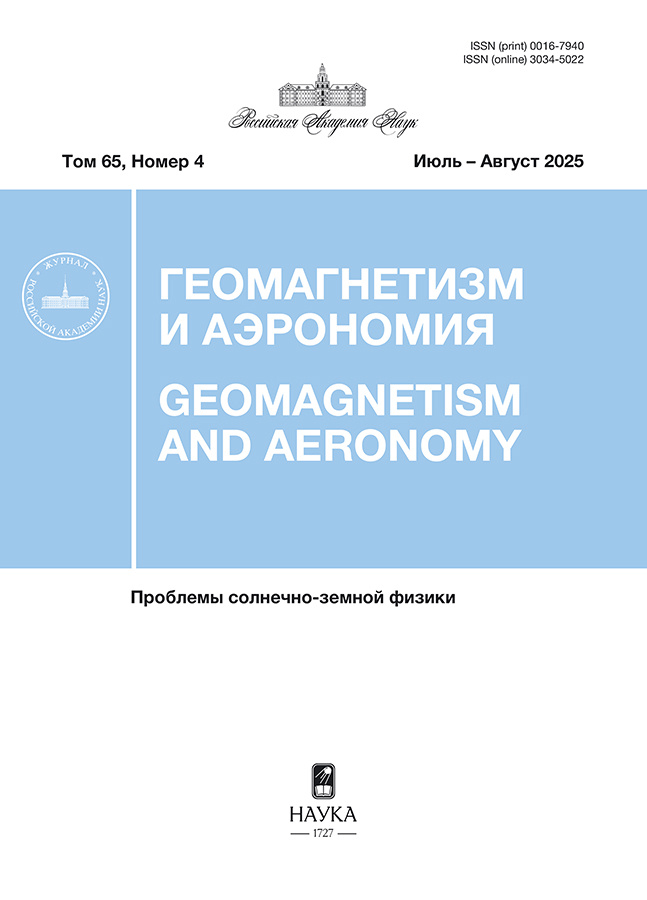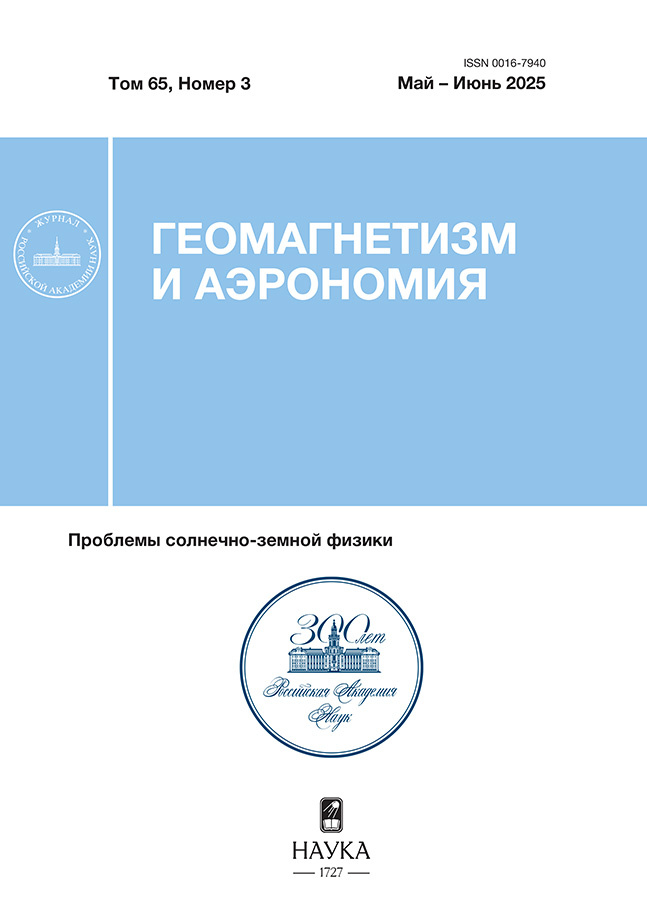Forecast Estimation of Galactic Cosmic Ray Modulation in the 25th Solar Cycle
- Authors: Struminsky A.B.1, Belov A.V.2, Guschina R.T.2, Yanke V.G.2, Grigoryeva I.Y.3
-
Affiliations:
- Space Research Institute of the Russian Academy of Sciences
- Pushkov Institute of Terrestrial Magnetism, Ionosphere and Radio Wave Propagation of the Russian Academy of Sciences
- Main (Pulkovo) Astronomical Observatory of the Russian Academy of Sciences
- Issue: Vol 65, No 3 (2025)
- Pages: 324-334
- Section: Articles
- URL: https://rjonco.com/0016-7940/article/view/686967
- DOI: https://doi.org/10.31857/S0016794025030039
- EDN: https://elibrary.ru/ESAAGB
- ID: 686967
Cite item
Abstract
The difference in the shape of the maxima of galactic cosmic rays (GCR) fluxes for positive (A > 0, even–odd cycle minima) and negative (A < 0, odd–even cycle minima) polarities of the solar dipole magnetic field is well known. For A > 0, a flat GCR maximum is observed, while for A < 0, a sharp one. This difference is associated with the influence of the drift mechanism of GCR propagation in the global magnetic field of the heliosphere, the proxy of which can be considered the polar (dipole) magnetic field of the Sun (Bpole). A homogeneous series of GCR data has been available since 1957, while Bpole observations have been conducted only since 1976. Using the example of odd (21st, 23rd and 25th) and even (22nd and 24th) cycles for which Bpole and GCR observations are available, we investigate the hypothesis that changes in the Bpole value and sign determine the main trends in the development of the entire modulation cycle. Traditionally, the beginning of the 11-year cycle in the long-term GCR modulation is associated with the minimum number of sunspots Rz, but the growth of Rz does not reflect all physical processes on the Sun capable of modulating GCR in the heliosphere. We select the maximum GCR intensity at 10 GV as the beginning of the modulation cycle (zero on the time scale) and then compare the count rate of the Moscow neutron monitor, the Bpole value, and the number of sunspots (Rz) using the superposition of epochs method. With such a choice of zero, the difference in the time profiles of GCRs in even and odd cycles is clearly visible. With a decrease in the Bpole module, the GCR fluxes decrease, the convective transport mechanism prevails, and the effect of drift transport is not visible (there is no clear division into even and odd cycles). With an increase in the Bpole module, the GCR fluxes grow, the diffusion mechanism of GCR transport prevails, which is helped or hindered by the drift mechanism (at A > 0 or at A < 0). The GCR fluxes remain constant at Bpole ~ const. The spot activity Rz is asymmetrical relative to the moment of polarity reversal (Bpole = 0), it is early in even and late in odd cycles. The discovered trends allow us to qualitatively predict the corridor of possible changes in Bpole and GCR fluxes in the decline phase of the 25th cycle and in the minimum of 25–26 cycles, as well as to make an epignostic forecast based on observations of GCR and Rz of possible Bpole values in 1957–1976 (the end of the 19th and the entire 20th cycle).
Full Text
About the authors
A. B. Struminsky
Space Research Institute of the Russian Academy of Sciences
Author for correspondence.
Email: astrum@cosmos.ru
Russian Federation, Moscow
A. V. Belov
Pushkov Institute of Terrestrial Magnetism, Ionosphere and Radio Wave Propagation of the Russian Academy of Sciences
Email: astrum@cosmos.ru
Russian Federation, Troitsk
R. T. Guschina
Pushkov Institute of Terrestrial Magnetism, Ionosphere and Radio Wave Propagation of the Russian Academy of Sciences
Email: astrum@cosmos.ru
Russian Federation, Troitsk
V. G. Yanke
Pushkov Institute of Terrestrial Magnetism, Ionosphere and Radio Wave Propagation of the Russian Academy of Sciences
Email: yanke@izmiran.ru
Russian Federation, Troitsk
I. Yu. Grigoryeva
Main (Pulkovo) Astronomical Observatory of the Russian Academy of Sciences
Email: astrum@cosmos.ru
Russian Federation, Saint Petersburg
References
- Гущина Р.Т., Белов А.В., Обридко В.Н., Шельтинг Б.Д. Проявления циклических вариаций магнитного поля Солнца в долговременной модуляции космических лучей // Геомагнетизм и аэрономия. Т. 48. № 5. С. 598–604. 2008
- Крайнев М.Б., Базилевская Г.A., Калинин М.С., Михайлов В.В., Свиржевская А.К. Свиржевский Н.С. Пятьдесят лет исследования поведения интенсивности ГКЛ в периоды инверсии гелиосферного магнитного поля. I. Наблюдаемые эффекты //Солнечно-земная физика. Т. 9. № 4. С. 5−20. 2023
- Ныммик Р.А. Модель галактических космических лучей, Глава 1.6 в книге Модель космоса: научно-информационное издание в 2 т. / Под редакцией М.И. Панасюка, Л.С. Новикова. Т. 1: Физические условия в космическом пространстве. М.: КДУ, 2007. 872 с.: табл. ил.
- Обридко В.Н. Магнитные поля и индексы активности, параграф 1.4 Главы 1 в книге Плазменная гелиогеофизика. В 2 т. Т. I / Под ред. Л.М. Зеленого и И.С. Веселовского. М.: ФИЗМАТЛИТ, 2008. - 672 с.
- Aguilar M., Ali Cavasonza L., Ambrosi G., Arruda L., Attig N. et al., (AMS Collaboration). Temporal Structures in Electron Spectra and Charge Sign Effects in Galactic Cosmic Rays // Phys. Rev. Lett. V. 130. 161001. 2023. https://doi.org/10.1103/PhysRevLett.130.161001
- Babcock H.W. The topology of the Sun’s magnetic field and the 22-year cycle //Astropys. J. V. 133. P. 572–578. 1961. https://doi.org/10.1086/147060
- Belov A. Large scale modulation: view from the Earth // Space Sci. Rev. V. 93. P. 79–105. 2000. https://doi.org/10.1023/A:1026584109817
- Charbonneau P. Dynamo models of the solar cycle // Living Reviews in Solar Physics. V. 17. Iss. 4. 2020. https://doi.org/10.1007/s41116-020-00025-6
- Cliver E.W. The Extended Cycle of Solar Activity and the Sun’s 22-Year Magnetic Cycle // Space Sci. Rev. V. 186. P. 169–189. 2014. https://doi.org/10.1007/s11214-014-0093-z
- Cliver E.W., Richardson I.G., Ling A.G. Solar Drivers of 11-yr and Long-Term Cosmic Ray Modulation // Space Sci. Rev. V. 176. P. 3–19. 2013. https://doi.org/10.1007/s11214-011-9746-3
- Fisk L.A., Axford W.I. Solar Modulation of Galactic Cosmic Rays, 1 // J. Geophys. Res. V. 74. N 21. P. 4973–4986.1969. https://doi.org/10.1029/JA074i021p04973
- Gleeson L.J., Axford W.I. Cosmic Rays in the Interplanetary Medium // Astrophys. J. V. 149. P. L115–L118. 1967. https://doi.org/10.1086/180070
- Hale G.E., Ellerman F., Nicholson S.B., Joy A.H. The magnetic polarity of Sun-spot // Astrophys. J. V. 49. P.153. 1919. https://doi.org/10.1086/142452
- Hathaway D.H. The Solar Cycle // Living Rev. Solar Phys. V. 12. P. 4. 2015. https://doi.org/10.1007/lrsp-2015-4
- Jha B.K. and Upton L.A. Predicting the Timing of the Solar Cycle 25 Polar Field Reversal // Astrophys. J. V. 962. P. L15-L21. 2024. https://doi.org/10.3847/2041-8213/ad20d2
- Jiang J., Cameron R.H., and Schüssler M. The cause of the weak solar cycle 24 // Astrophys. J. Lett. V. 820. P. L28-L34. 2015. https://doi.org/10.1088/2041-8205/808/1/L28
- Jokipii J.R, Levy E.H., and Hubbard W.B. Effects of particle drift on cosmic-ray transport. I. General properties, application to solar modulation // Astrophys. J. V. 213. P. 861−868. 1977. https://doi.org/10.1086/155218
- Jokipii J.R., Thomas B. Effects of drift on the transport of cosmic rays IV. Modulation by a wavy interplanetary current sheet // Astrophys. J. V. 243. P. 1115−1122.1981. https://doi.org/10.1086/158675
- Khabarova O., Malandraki O., Malova H., Kislov R. et al. Current Sheets, Plasmoids and Flux Ropes in the Heliosphere Part I. 2-D or not 2-D? General and Observational Aspects // Space Sci. Rev. V. 217:38. 2021. https://doi.org/10.1007/s11214-021-00814-x
- Kumar P., Nagy M., Lemerle A., Karak B.B., Petrovay K. The polar precursor method for solar cycle prediction: comparison of predictors and their temporal range// Astrophys. J. V. 909. P 87−99. 2021. https://doi.org/10.3847/1538-4357/abdbb4
- Kumar P., Karak B.B., Sreedevi A. Variabilities in the polar field and solar cycle due to irregular properties of bipolar magnetic regions // MNRAS. V. 530. P. 2895–2905. 2024. https://doi.org/10.1093/mnras/stae1052
- Leighton R.B. Transport of magnetic fields on the Sun // Astrophys. J. V. 140. P. 1547–1562. 1964. https://doi.org/10.1086/148058
- Leighton R.B. A magneto-kinematic model of the solar cycle //Astrophys. J. V. 156. P. 1–26. 1969. https://doi.org/10.1086/149943
- Liu W., Guo J., Wang Yu., and Slaba T.C. A Comprehensive Comparison of Various Galactic Cosmic-Ray Models to the State-of the-art Particle and Radiation Measurements // Astrophys. J. V. 271. P. 18−47. 2024. https://doi.org/10.3847/1538-4365/ad18ad
- Martin S.F. Observations key to understanding solar cycles: a review // Front. Astron. Space Sci. V. 10:1177097. 2024. https://doi.org/10.3389/fspas.2023.1177097
- Nandy D. Progress in Solar Cycle Predictions: Sunspot Cycles 24–25 in Perspective // Solar Phys. V. 296:54. 2021. https://doi.org/10.1007/s11207-021-01797-2
- Owens M.J., Lockwood M., Barnard L. A. et al. Extreme Space-Weather Events and the Solar Cycle // Solar Phys. V. 296:82. 2021. https://doi.org/10.1007/s11207-021-01831-3
- Pal S. and Nandy D. Algebraic quantification of the contribution of active regions to the Sun’s dipole moment: applications to century-scale polar field estimates and solar cycle forecasting // MNRAS. V. 531. P. 1546–1553. 2024. https://doi.org/10.1093/mnras/stae1205
- Parker E.N. The Passage of Energetic Particles through Interplanetary Space //Planetary Space Sci. V. 13. P. 9–49. 1965. https://doi.org/10.1016/0032-0633(65)90131-5
- Paouris E., Mavromichalaki H., Belov A, Gushchina R., Yanke V. Galactic Cosmic Ray Modulation and the Last Solar Minimum // Solar Phys. 2012. V. 280. P. 255–271. https://doi.org/10.1007/s11207-012-0051-4
- Petrovay K. Solar cycle prediction // Living Rev. Sol. Phys. V. 17: 2. 2020. https://doi.org/10.1007/s41116-020-0022-z
- Svaalgaard L., Wilcox J. A View of Solar Magnetic Fields, the Solar Corona and the Solar Wind in Three Dimensions // Ann. Rev. Astron. Astrophys. V. 16. P. 429−443. 1978. https://doi.org/10.1146/annurev.aa.16.090178.002241
- Stozhkov Yu.I., Makhmutov V.S., Svirzhevsky N.S. About cosmic ray modulation in the heliosphere // Universe. Vol. 8. Iss. 11. P. 558. 2022. https://doi.org/10.3390/universe8110558
- Wang Y.-M. The Radial Interplanetary Field Strength at Sunspot Minimum as Polar Field Proxy and Solar Cycle Predictor //Astrophys. J. Lett. V. 96. P. L27-L36. 2024. https://doi.org/10.3847/2041-8213/ad1c65
- Yanke V.G., Belov A.V., Gushchina R.T., Kobelev P.G., Trefilova L.A. Forecast of Modulation of Cosmic Rays with Rigidity of 10 GV in the 25th Solar Activity Cycle // Geomagn. Aeronomy. V. 64. N 2. P. 201–210. 2024. https://doi.org/10.1134/S0016793223601072
Supplementary files














